What is System Testing: It's Types With Best Practices
- Learning Hub
- What is System Testing: It's Types With Best Practices
CHAPTERS
- Overview
- What is System testing
- Why should you consider System testing
- Scope of System testing
- Basic requirements of System testing
- What do you verify in System testing
- Positive aspects of System testing
- Phases of System testing
- System testing types
- System testing: Is it White box or Black box testing?
- Tools for System testing
- How System testing fits with other QA methods
- An example of a System test case
- How to perform System testing using LambdaTest
- Limitations of System testing
- System testing vs Acceptance testing
- Best Practices of System testing
- Frequently Asked Questions (FAQs)
OVERVIEW
System testing, also known as system-level testing, involves evaluating how the various components of an application interact in a fully integrated system. It is carried out on the entire system under either functional or design requirements.
It helps you find flaws, gaps, or needs that are lacking from the software application's overall functionality. It validates the design, behavior, and customer expectations of the system. Software Requirements Specification (SRS) is necessary to function the system outside the specified restrictions.
Functional and non-functional System testing can be performed by your company internally. However, you can hire professionals with in-depth knowledge of the complete procedure. It is important to note that System testing is performed by a separate team from the development team. It aims to measure the quality of the system objectively.
In this System testing tutorial, learn why System testing is important and all the intricacies of the System testing process.
What is System testing?
System testing helps to understand how the end users will utilize the software applications and what issues they might encounter. However, understanding the application is just as crucial as having a requirements document.
It is indeed typically accomplished by software testing engineers. Its performance occurs in a context comparable to the one used in production, permitting the developers and other relevant parties to analyze user responses.
The below flowchart shows where the System testing happens in the software development life-cycle.
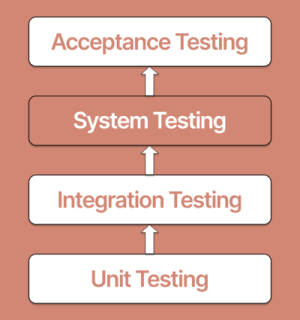
It is important to follow a specific order when testing software. Following is a chronologically organized list of software testing categories.
- Unit testing - During development, each module or block of code is subjected to unit testing. Most of the time, the programmer who writes the code is responsible for unit testing.
- Integration testing - It occurs before, during, and after integrating a new module into the main software package. This includes testing each code module. A single piece of software may comprise various modules, which are frequently built by multiple developers.
- System testing - A high-skilled software tester performs System testing on the entire software application before it is released to the general public.
- Acceptance testing - Acceptance testing and beta testing of a software application are performed by real end users.
Why should you consider System testing?
The flowchart above shows that System testing comes after integration testing but before acceptance testing. A component or system's observed behavior during testing is the outcome of System testing because it's crucial to thoroughly test a software application before making it available to users.
- System testing ensures that the system satisfies its goals and specifications. An entire test cycle must reach its completion, and System testing is where you can accomplish it.
- It determines whether the system adequately spaces out when designed.
- System testing is a procedure that confirms the accuracy and checks for completeness. Since System testing is carried out in a setting akin to the production environment, stakeholders can accurately predict the user's response.
- One of its key goals is to ensure that the system complies with its requirements and operates as anticipated.
Scope of System testing
Until now, in this System testing tutorial, we have got a good gist of what System testing is. Let’s look at the scope of it.
- Implementing System testing methodology lays out a procedure for confirming the functionality of a fully-fledged, integrated system to prevent defects.
- It aids in reducing troubleshooting and support calls made after deployment, making sure to find flaws, inadequacies, or unmet requirements.
- System testing also helps determine whether it complies with the specifications listed in the system specification.
- In System testing, the business requirements and the application architecture pass through tests to identify and fix the problems ahead of time to help decrease risks and ensure smooth operation. As a result, this testing is crucial and helps to ensure that the consumer receives a high-quality software application.
Basic requirements of System testing
A system test's objective is to assess the complete system requirements. System testing consists of several tests to exercise the entire computer-based system. To achieve your end goal, you must abide by the factors listed below while executing system test operations.
- Industry type: To comprehend the testing process and ensure you have the resources to do the assignment, be aware of the industry vertical to which your organization belongs. An organization can employ more automatic analyses, like something of a functionality evaluation, if it chooses a more practical methodology. Rather than using a conventional analysis like exploratory testing, an organization may choose to adopt a user's perspective to discover flaws.
- Testing time needed: System testing may execute several tasks and take more time to complete in some contexts, particularly when regular monitoring becomes necessary. You must be aware of the time commitment you can make to testing. It will offer you a realistic notion of the progress and assist you in arranging your work.
An organization may highlight system tests that require minimal steps if its product release deadlines are shorter, or it may adjust screening procedures to accommodate its specifications.
- Resources at your disposal for testing: As previously said, when making plans for System testing, you must consider your test team's size, expertise, and experience. You may need to train your current personnel or hire extra testers based on the size and complexity of your application.
- Background of tester: Planning for System testing should consider the testers' experience. The test cycle could take longer to complete if the testers are inexperienced. However, if they had previous experience, it would take less time.
- Entire testing expense: When developing your test strategy, it's crucial to keep the entire cost of testing in mind. System testing may be a costly procedure. The size and complexity of the system, the number of test cases needed, and the time and resources required to carry out the tests are just a few of the numerous variables that might affect the cost of System testing.
What do you verify in System testing?
The software application code is tested as part of System testing for the following areas:
- Checking how components interact with one another and the system as a whole. This involves testing the fully integrated programs with external peripherals. This scenario is also known as end to end testing.
- Check for intended results by thoroughly checking each input in the program.
- Evaluation of the application's user experience.
This gives a very brief overview of what goes into System testing. You must create thorough test cases and test suites that evaluate every program component from the outside without access to the source code.
Positive aspects of System testing
Each Software testing method that is now accessible has its learning curve. A tester must learn how to operate some of the software involved. Large businesses employ different strategies than medium-sized and small businesses.
- This testing examines the business needs as well as the application architecture. Testers don't need additional programming expertise to execute the System testing methodology.
- If this testing is carried out methodically and correctly, it will reduce post-production problems. It will test the complete piece of hardware or software, allowing us to quickly find any flaws or issues that slipped through integration and unit testing.
- The test environment is comparable to live, working, or commercial settings. End to end testing of the system is part of this testing.
- System testing is carried out in an environment that is identical to the production environment, which aids in understanding the user's perspective and helps avoid problems arising after the system goes live. It also addresses users' technical and business needs while using various test scripts to verify the system's complete performance.
Following System testing, the software application will have practically all potential flaws or faults fixed, allowing the development team to go on to acceptance testing safely.
Phases of System testing
System testing can be more successful with a focused and clear requirement document that includes the most recent modifications and comprehension of real-time application usage. It establishes clarity in requirements to have a smooth functional performance and fulfil the security and recoverability expectations. Further, the tester must also be aware of how the program in OS versions used is in practice.
Depending on the development lifecycle model, you can perform Component testing in isolation from other system components. The isolation is used to keep external influences away. So, to test that component, you need to simulate the interaction between the software application's components using stubs and drivers.
From the flowchart below, you can understand the different phases of System testing easily.
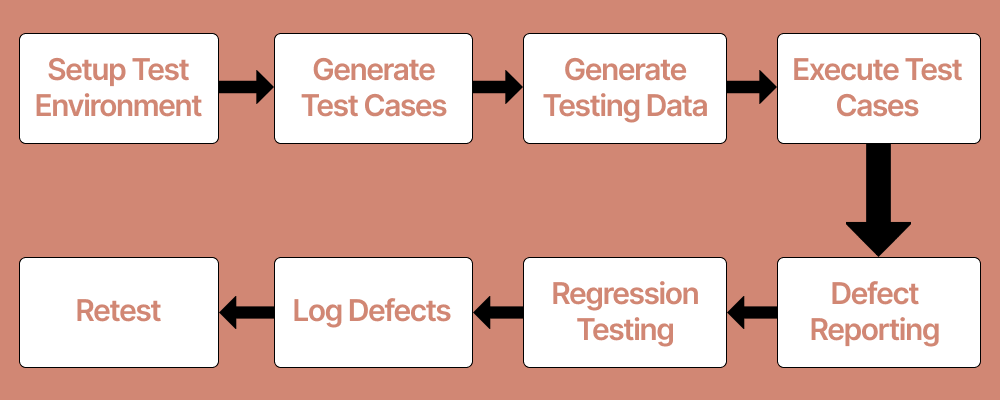
- Analyzing the requirements to build the test environment: Setting up the test environment comprises identifying the frameworks, programming language(s), and testing tools the tester will use and establishing any necessary dependencies and configurations.
- Making of a test case: It covers all the precise information regarding what you must test and how to conduct the test. The test case document should also include what counts as a pass or fail for each test.
- Development of test data: Test data generation comes after the test case. The inputs and outputs' findings may be both favorable and unfavorable. One must be extremely careful when gathering test data to include all necessary fields and not overlook any significant area.
- Implementing the test case: After that, you should have a plan for running the test case to produce an output. The output will indicate whether the test case was successful or unsuccessful.
- Bug reporting: The test case should demonstrate how the system responds to an error or flaw. We must comprehend the reporting and resolve issues to plan System testing appropriately.
- Regression testing: A tester opts for regression testing to avoid the broken functionality problems that may arise due to new features. Various tools are available to automate this process.
- Fixing errors: Having a strategy in place to address flaws is also crucial. Although it is difficult to manage all faults, success depends on having a procedure to identify and fix them.
- Retesting: The development team should fix a fault after it has been discovered and recorded by a tester, and the tester should then confirm that the repair functions as intended. If you don't do this, you risk your software having undetected flaws. When necessary, you must prepare for either a complete or selective retesting.
System testing types
Due to its inclusion of all the major testing kinds, System testing is a superset of all testing types. Although the emphasis on particular testing methods may change depending on the product, organizational procedures, deadline, and requirements.
- Functionality testing: It determines whether the system, particularly its features, complies with the requirements to confirm that the product's functionality complies with the specified standards while staying within the bounds of the system.
During functional testing, testers could compile a list of potential extra features a product could have to enhance it. The available analysis represents testing environments in both manual and automated testing methods.
- Recoverability testing: Testing for recoverability helps you to see if the system can bounce back from crashes, hardware failures, and other significant issues determining how effectively the method jumps back from different input errors and other failure scenarios.
Additionally, it ensures that no problems from the past recur as more software modules keep adding to the queue over time. It gauges the system's resilience to unforeseen inputs and circumstances.
- Performance testing: Verify the components of your system to abide by the performance characteristics through performance testing. It establishes if a system achieves its performance goals, such as throughput or reaction time.
- Usability testing: In usability testing, the tester must examine the system's user-friendliness to guarantee that the system is simple to understand, operate, and use. Participants in the test must carry out some tasks with the system. It would be best if you optimized an excellent scrutinized performance and any issues that may evolve while running the application.
- Regression testing: It ensures that new system modifications don't compromise existing functionality and is crucial to ensure the system's stability as it integrates various subsystems and maintenance procedures. This testing contrasts the system's present behavior with a previous iteration.
- Hardware/Software testing: You can test both hardware and software of a system using System testing. IBM refers to both hardware and software testing as HW/SW testing. Here, the system's operation evaluates without considering its structural elements.
The functionality of each piece of hardware examines to ensure that it functions as intended. Testing the system's wiring, power supply, and input/output components may be necessary—the functionality of each software that makes up the evaluated system.
System testing: Is it White box or Black box testing?
System testing comes under the classification of the black-box test method. Although the white box technique requires internal code knowledge, the black box testing technique does not.
Testers include functional and non-functional System testing, security testing, performance testing, and other addressed test cases. Here, components that passed the integration test are used as input and tested using the black-box methodology. The purpose of integration testing is to find discrepancies between the integrated units and the output, which is confirmed.
However, let us look into the entry and exit criteria to plan the System testing.
Entry requirements: The system should have met the integration testing exit criteria, meaning that all test cases should reach their endpoint, and there shouldn't be any open critical or priority bugs.
- The test plan should be authorized and signed off.
- Execution of the scenarios and test cases should be as per the preparation.
- A proper framework of designed test scripts must abide by the implementation strategy.
- There should be test cases for each non-functional requirement, and they should all be available.
- The testing set ought to be ready to execute.
Exit standards: Shown below are a few of the exit standards for the system.
- Execute each test case.
- There shouldn't be any open critical, priority, or security-related problems.
- If any medium or low-priority issues are still outstanding, the developer should fix them with the customer's consent.
- The tester must turn in the exit report to keep a performance record.
Tools for System testing
Following is the list of tools that get along well with System testing.
- Robot: The Robot framework comes with several pre-built tools and libraries, but you may also make your own. Its application and operating system are separate. Although Java and .NET have interfaces in the standard library, Python is used to implement the core framework.
- Gallen: You can automate System testing using the Gallen framework. It is simple to include in our development process as the framework belongs to the open-source category.
- Selenium: Selenium is an open-source test automation framework used to automate web application testing across different browsers and platforms. Testers can speed up testing cycles by automating repeated test cases with the Selenium framework. As a part of a CI/CD pipeline, Selenium can also help ensure a stable and bug-free release deployment process.
- JMeter: JMeter is one of the performance testing tools that help you conduct performance testing of websites and web applications. It can simulate a great demand on a network or other object to assess a server's durability or examine its overall performance under various load types.
- LambdaTest: LambdaTest is a cloud-based testing platform to help you perform System testing over its secure and scalable online Selenium Grid. With LambdaTest, you can automate cross browser testing across 3000+ operating systems, browsers, and OS, resulting in increased test coverage and much faster build times.
You can assess how effectively your web application renders across various browsers and OS combinations. Using LambdaTest Tunnel, you can test locally hosted web pages. A single test might potentially be executed parallel on several browsers and OS configurations.
Also, explore the top robot framework interview questions. The robot framework simplifies software testing with Python, making it valuable for online, mobile, desktop, and API testing. Ace your interview with our expertly curated questions.
How System testing fits with other QA methods
Software testing encompasses a variety of techniques with several involved processes. Applications have many components that need examination before being released. Sometimes, IT professionals have trouble understanding these QA testing approaches' jargon.
After developers have integrated and tested all its components, system testing takes the application. An application is practically ready for production at this point, and this process ensures that the code satisfies all specifications before going live. This test level involves a variety of non-functional tests, like performance and load testing, to look at the application's customer-facing features.
An example of a System test case
This section of the System testing tutorial will help you to understand how System testing works with an example.
- Firstly, a tester must check if the website loads smoothly, includes all the necessary functions, pages, and logos, and if a user can access the site and log in. The user must be able to add items to his cart, complete the purchase, and receive a confirmation via email, SMS, or phone call if he can see the available products.
- Next, the tester must check that the site can simultaneously accommodate the number of users (as specified in the requirement specification). Further, the primary features, such as searching, filtering, sorting, adding, altering, wishlist, etc., must function as intended.
- A tester should check if the website functions well across all platforms, including Windows, Linux, mobile, etc., loads in all popular browsers, and its recent versions with the text on the pages correctly spaced, organized, and free of typos. Further, the tester also verifies if the session timeout is working as expected.
- Lastly, the tester must verify that the user manual or guide, return policy, privacy policy, and terms of service are all provided as separate documents. The ability to download the same by new or first-time users would help ensure that the transactions made on the website through a particular user are safe. The end-user must be pleased with the website after using it and should face no hiccups.
How to perform System testing using LambdaTest?
There are many ways to perform System testing. You can do it manually or through automation. To streamline your testing process and avoid the hassle of maintaining in-house device labs, you can use cloud-based platforms like LambdaTest.
It enables simple access to the cloud environment, making software testing a manageable and scalable procedure. LambdaTest gives you access to an online browser farm and device farm for your mobile and web testing needs.
- Sign in to your LambdaTest account. Register for free if you don't already have an account.
- Navigate to Real Time Testing > Browser Testing from the left sidebar.
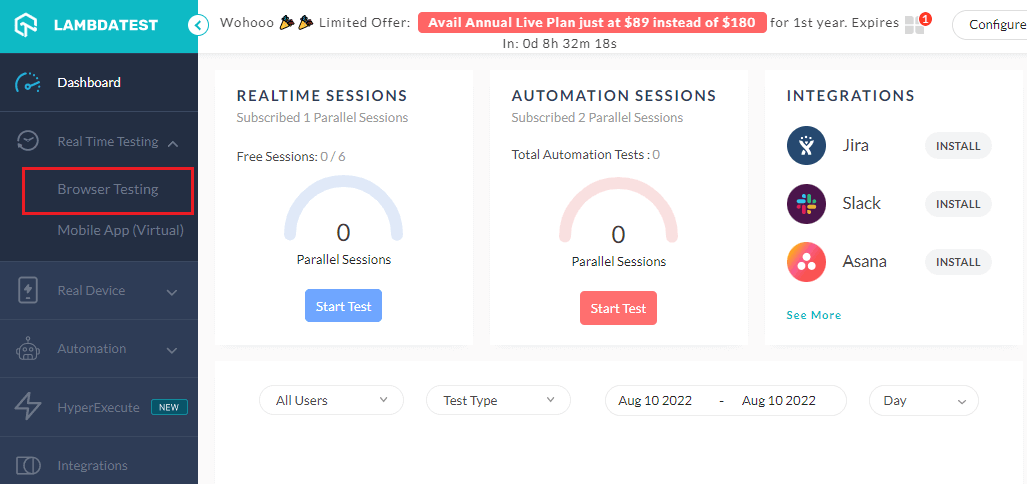
- Enter the URL, and select the browser VERSION, OS, and RESOLUTION. Then, click START.
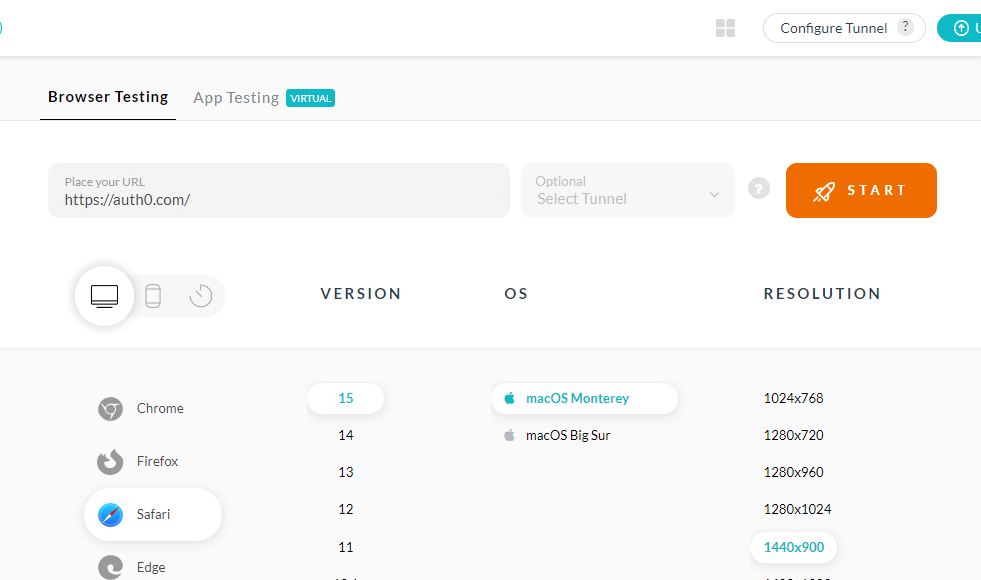
Below are the steps to perform live-interactive System testing on the LambdaTest platform.
A cloud-based virtual machine will launch running a real operating system. Here you can perform live-interactive System testing of your web applications.
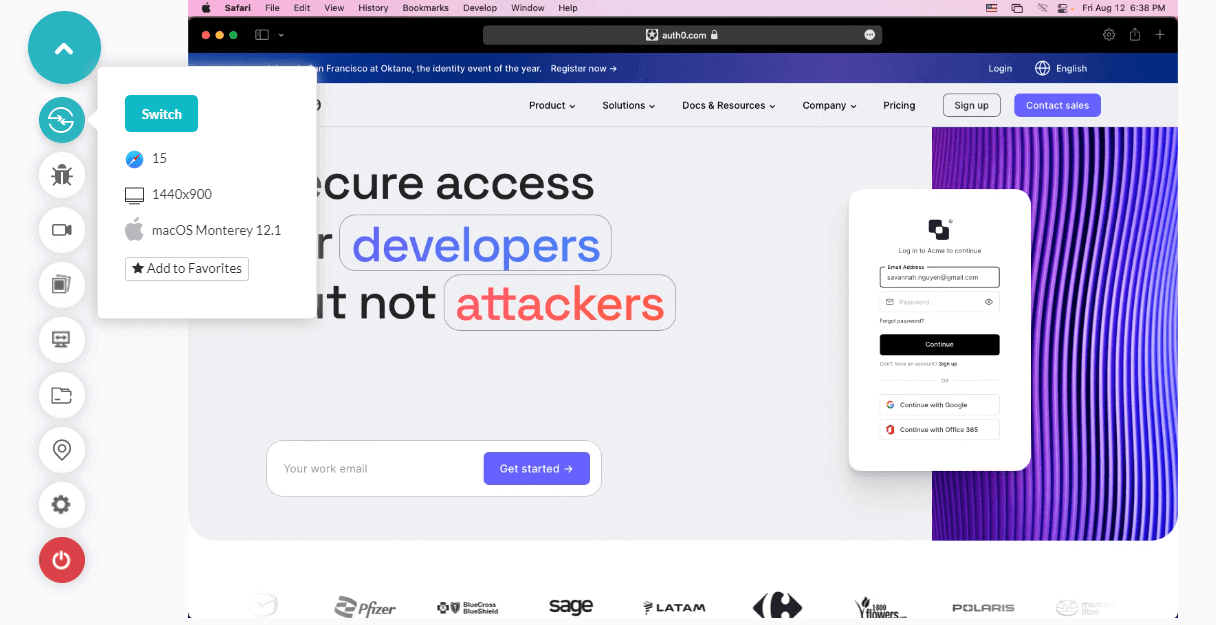
LambdaTest platform is also equipped with a real device cloud to test web and mobile apps in real-world conditions and gives you accurate results.
Check out the video tutorial on performing real device testing on the LambdaTest platform.
Subscribe to LambdaTest YouTube Channel, and check out the latest tutorials around Selenium automation testing, Cypress E2E testing, real-time testing, and more.
Limitations of System testing
Despite many benefits, System testing has many limitations too. Following are some of its limitations.
- Need debugging tools and highly competent testers.
- Results will be more effective, but the process may become costlier depending on the available resources.
- Even if every route in the source code is examined, there is still a potential that certain bugs may go undetected.
- Compared to other types of software testing, testing the entire system requires more time.
System testing vs Acceptance testing
In this section of the System testing tutorial, let’s look at how System testing differs from acceptance testing.
| System testing | Acceptance testing |
|---|---|
| Verifies whether the software application meets the specified requirements or not. | Verifies whether the software application meets the end-user requirements or not. |
| Used by developers and testers. | Used by testers, users, and stakeholders. |
| It involves both functional and non-functional testing. | It involves functional testing only. |
| It takes place before acceptance testing. | It takes place after System testing. |
| It checks for dummy inputs. | It checks for random inputs. |
| It consists of both system and integration testing. | It consists of both alpha and beta testing. |
| It is possible to fix defects found during testing. | An acceptance test for a product that finds any defects is considered a failure. |
| Testing a system involves both positive and negative cases. | It involves positive test cases only. |
Best Practices of System testing
This section of the System testing tutorial lists some of the best practices for running a system test.
- Instead of performing ideal testing, you must opt for simulating real-world circumstances because end users will be using the system, not skilled testers. Further, try to verify the system's answer multiple times because people do not like waiting or viewing inaccurate information. The end user will install and configure the system following the documentation.
- A better system can be sent in by including individuals from many fields, such as business analysts, developers, testers, and customers. So, routine testing is the only way to ensure that even the most minor update in the code to remedy a bug hasn't introduced another severe bug into the system.
- Humans do not like to wait or see incorrect data, so they verify the system's response in various ways.
- As the end-user will be configuring the system, install and configure it according to the documentation.
- Testing regularly ensures that even the most minor change in the code to fix a bug doesn't introduce another critical bug.
- To minimize the possibility of outside interference and deliver reliable assessments to an organization, ensure you can execute each test case in the same conditions. Simulate a prospective customer's environment in your user-based tests to improve them. To guarantee that all testers are aware of the requirements, it could be essential to produce a comprehensive document.
Analyzing these documents can enable you to comprehend the appropriate measures and increase competitiveness. Stay on top of and highlight any errors you discover, then indicate to a developer how to fix them by modifying the coding language. Consider implementing a management structure that satisfies your demands and expectations to develop an efficient report during the process.
Summing up
Software testing provides a standardized procedure. Identifying the test environment, establishing test scenarios, writing scripts, assessing test results, and sending defect reports are tasks or steps.
Application programming interface (API), user interface, and system levels are all included in a comprehensive testing strategy. Moreover, the more early and completed automated tests, the better. Some work together to develop their customized internal test automation frameworks.
System testing is crucial to ensure quality control. Hence, it carries its importance throughout the software development cycle. It is essential; serious problems could arise in real-world environments if done incorrectly.
You can ask experts to perform System testing services for your organization if the procedure appears too daunting and you are unsure where to begin. However, you must go through System testing to test every aspect of the website.
Frequently Asked Questions (FAQs)
What are types of System testing?
System testing is of multiple types like regression, load, functional, recovery, migration, usability, software, and hardware testing.
Why do we do System testing?
System testing is performed on an entire integrated system to check the system's compatibility with its specified requirements.
What is system testing?
System testing is the process of testing a complete and integrated software system to ensure that it meets the specified requirements and functions as intended in a real-world environment.
What are some examples of system testing?
Here are the system testing examples: Regression Testing, Load Testing, Functional Testing, Recovery Testing, Migration Testing, Usability Testing, Software and Hardware Testing
What is system integration testing?
System integration testing is a type of testing where different components or modules of a system are tested together to ensure they work properly when integrated and to identify any issues or conflicts between them.
What is system testing in software engineering?
System testing in software engineering is the evaluation of the integrated system or application by the QA team to ensure that all the components work together effectively. It focuses on verifying the interactions and functionality of the entire system.
What is functional system testing?
Functional system testing is a type of testing that verifies whether each feature of an application functions correctly according to the software requirements. It ensures that the output of each function aligns with the expectations of end users, validating the functionality of the system.
Why is system testing important?
System testing is important because it ensures that all components of an application work together seamlessly, validating the functionality, reliability, and performance of the system as a whole. It helps identify and fix issues before the product is released, improving product quality and user satisfaction.
What is embedded system testing?
Embedded system testing involves the evaluation of both software and hardware components to ensure the absence of defects in the final product. It verifies if the embedded hardware and software meet the business requirements, encompassing functional and non-functional aspects of the system.
What is involved in system testing?
System testing involves a comprehensive evaluation of all application components to ensure their seamless integration and functionality as a unified entity. It is conducted by the QA team after individual module testing and integration testing to verify the system's performance, reliability, and compliance with requirements.
How to perform system testing?
To perform system testing, follow these steps: 1. Understand requirements, Develop a test plan, 3. Design test cases, 4. Set up the test environment, 4. Execute test cases, 5. Report and track issues, 6. Validate system behavior, 7. Conduct regression testing, 8. Obtain stakeholder feedback, 9. Finalize test documentation.
Who performs system testing?
System testing is typically performed by the quality assurance (QA) team or dedicated testers responsible for evaluating the overall functionality and performance of the integrated system or application.
Try LambdaTest Now !!
Get 100 minutes of automation test minutes FREE!!

Did you find this page helpful?
Author's Profile

Bhavya Hada
Bhavya Hada is serving as a Product Specialist at LambdaTest. With over a year of specialized experience, she plays a pivotal role in shaping the company's product marketing strategies. Her dedication to innovation in testing is not just about ensuring browser compatibility. Bhavya excels in bridging the gap between advanced testing technologies and practical development needs. In her tenure with LambdaTest, she has deepened her expertise in quality assurance and product development, becoming a cornerstone of the team.
Reviewer's Profile

Shahzeb Hoda
Shahzeb currently holds the position of Senior Product Marketing Manager at LambdaTest and brings a wealth of experience spanning over a decade in Quality Engineering, Security, and E-Learning domains. Over the course of his 3-year tenure at LambdaTest, he actively contributes to the review process of blogs, learning hubs, and product updates. With a Master's degree (M.Tech) in Computer Science and a seasoned expert in the technology domain, he possesses extensive knowledge spanning diverse areas of web development and software testing, including automation testing, DevOps, continuous testing, and beyond.
 Christmas Deal is on: Save 25% off on select annual plans for 1st year.
Christmas Deal is on: Save 25% off on select annual plans for 1st year.
